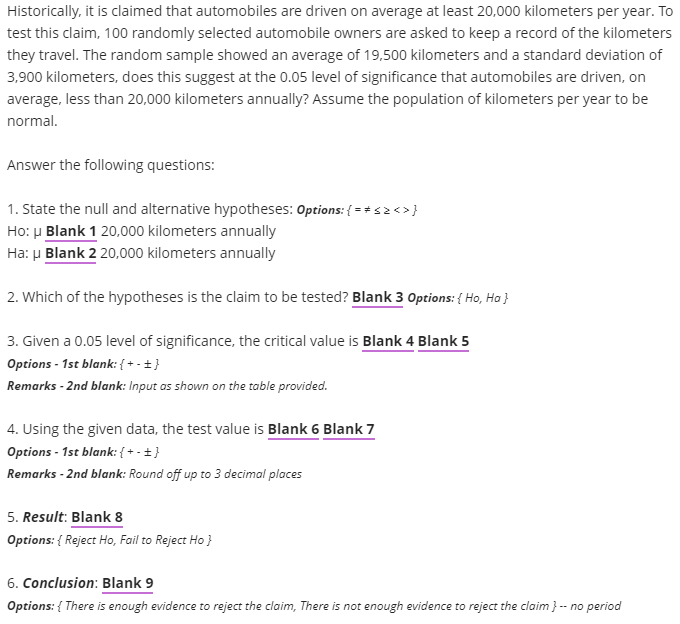listorically, it is claimed that automobiles are driven on average at least 20,000 kilometers per year. To est this claim, 100 randomly selected automobile owners are asked to keep a record of the kilometers ney travel. The random sample showed an average of 19,500 kilometers and a standard deviation of ,900 kilometers, does this suggest at the 0.05 level of significance that automobiles are driven, on verage, less than 20,000 kilometers annually? Assume the population of kilometers per year to be ormal. nswer the following questions: - State the null and alternative hypotheses: Options: { =s<>} lo: µ Blank 1 20,000 kilometers annually la: µ Blank 2 20,000 kilometers annually . Which of the hypotheses is the claim to be tested? Blank 3 Options: { Ho, Ha } . Given a 0.05 level of significance, the critical value is Blank 4 Blank 5 ptions - 1st blank: { +- ±} emarks - 2nd blank: Input as shown on the table provided. - Using the given data, the test value is Blank 6 Blank 7 ptions - 1st blank: {+-±} emarks - 2nd blank: Round off up to 3 decimal places . Result: Blank 8 ptions: { Reject Ho, Fail to Reject Ho } . Conclusion: Blank 9
listorically, it is claimed that automobiles are driven on average at least 20,000 kilometers per year. To est this claim, 100 randomly selected automobile owners are asked to keep a record of the kilometers ney travel. The random sample showed an average of 19,500 kilometers and a standard deviation of ,900 kilometers, does this suggest at the 0.05 level of significance that automobiles are driven, on verage, less than 20,000 kilometers annually? Assume the population of kilometers per year to be ormal. nswer the following questions: - State the null and alternative hypotheses: Options: { =s<>} lo: µ Blank 1 20,000 kilometers annually la: µ Blank 2 20,000 kilometers annually . Which of the hypotheses is the claim to be tested? Blank 3 Options: { Ho, Ha } . Given a 0.05 level of significance, the critical value is Blank 4 Blank 5 ptions - 1st blank: { +- ±} emarks - 2nd blank: Input as shown on the table provided. - Using the given data, the test value is Blank 6 Blank 7 ptions - 1st blank: {+-±} emarks - 2nd blank: Round off up to 3 decimal places . Result: Blank 8 ptions: { Reject Ho, Fail to Reject Ho } . Conclusion: Blank 9
A First Course in Probability (10th Edition)
10th Edition
ISBN:9780134753119
Author:Sheldon Ross
Publisher:Sheldon Ross
Chapter1: Combinatorial Analysis
Section: Chapter Questions
Problem 1.1P: a. How many different 7-place license plates are possible if the first 2 places are for letters and...
Related questions
Question
Need help ASAP :(

Transcribed Image Text:Historically, it is claimed that automobiles are driven on average at least 20,000 kilometers per year. To
test this claim, 100 randomly selected automobile owners are asked to keep a record of the kilometers
they travel. The random sample showed an average of 19,500 kilometers and a standard deviation of
3,900 kilometers, does this suggest at the 0.05 level of significance that automobiles are driven, on
average, less than 20,000 kilometers annually? Assume the population of kilometers per year to be
normal.
Answer the following questions:
1. State the null and alternative hypotheses: Options: { = *s2<>}
Ho: µ Blank 1 20,000 kilometers annually
Ha: u Blank 2 20,000 kilometers annually
2. Which of the hypotheses is the claim to be tested? Blank 3 Options: { Ho, Ha }
3. Given a 0.05 level of significance, the critical value is Blank 4 Blank 5
Options - 1st blank: { + - +}
Remarks - 2nd blank: Input as shown on the table provided.
4. Using the given data, the test value is Blank 6 Blank 7
Options - 1st blank: { + - ±}
Remarks - 2nd blank: Round off up to 3 decimal places
5. Result: Blank 8
Options: { Reject Ho, Fail to Reject Ho }
6. Conclusion: Blank 9
Options: { There is enough evidence to reject the claim, There is not enough evidence to reject the claim }-- no period
Expert Solution
This question has been solved!
Explore an expertly crafted, step-by-step solution for a thorough understanding of key concepts.
This is a popular solution!
Trending now
This is a popular solution!
Step by step
Solved in 2 steps with 1 images

Recommended textbooks for you

A First Course in Probability (10th Edition)
Probability
ISBN:
9780134753119
Author:
Sheldon Ross
Publisher:
PEARSON


A First Course in Probability (10th Edition)
Probability
ISBN:
9780134753119
Author:
Sheldon Ross
Publisher:
PEARSON
